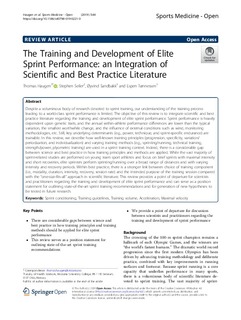| dc.description.abstract | Despite a voluminous body of research devoted to sprint training, our understanding of the training process leading to a world-class sprint performance is limited. The objective of this review is to integrate scientific and best practice literature regarding the training and development of elite sprint performance. Sprint performance is heavily dependent upon genetic traits, and the annual within-athlete performance differences are lower than the typical variation, the smallest worthwhile change, and the influence of external conditions such as wind, monitoring methodologies, etc. Still, key underlying determinants (e.g., power, technique, and sprint-specific endurance) are trainable. In this review, we describe how well-known training principles (progression, specificity, variation/periodization, and individualization) and varying training methods (e.g., sprinting/running, technical training, strength/power, plyometric training) are used in a sprint training context. Indeed, there is a considerable gap between science and best practice in how training principles and methods are applied. While the vast majority of sprint-related studies are performed on young team sport athletes and focus on brief sprints with maximal intensity and short recoveries, elite sprinters perform sprinting/running over a broad range of distances and with varying intensity and recovery periods. Within best practice, there is a stronger link between choice of training component (i.e., modality, duration, intensity, recovery, session rate) and the intended purpose of the training session compared with the “one-size-fits-all” approach in scientific literature. This review provides a point of departure for scientists and practitioners regarding the training and development of elite sprint performance and can serve as a position statement for outlining state-of-the-art sprint training recommendations and for generation of new hypotheses to be tested in future research. | nb_NO |

